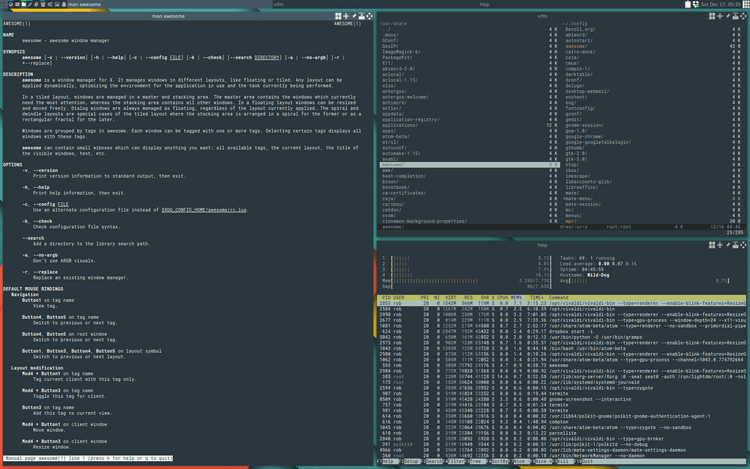
- #LINUX MOUSELESS WINDOW MANAGER FULL#
- #LINUX MOUSELESS WINDOW MANAGER SOFTWARE#
- #LINUX MOUSELESS WINDOW MANAGER WINDOWS#
I realized that with i3 I've been using more and more the terminal. Firefox, Chromium, Calculator, Nautilus, Gnome settings or Gimp, everything should be available and accessible trough the default dmenu. After you start i3 the first time, you are prompted for an initial configuration that will set the basics for you to get rolling.Īfter installation, you'll be prompted with this screen on your first loginīe assured that you will still use all your GUI applications with i3. That said, installation should be straightforward by using your package manager (see below). I3 is available on repositories for Fedora, Ubuntu, Arch and other major distros. For example, here are some of my custom bindings: Don't like that keybinding? Change your ~/.config/i3/config file and do your changes. The i3 configuration is simple to read, understand, share and modify. will make you more the terminal and terminal-based tools.will make you learn better the GNU/Linux operating system.will make you feel less tired after a day of work.can integrate with other tools of your system.has easy support for vertical and horizontal splits, and parent containers.has vim-like keybindings (yes, this is a plus!!).allows you to manage your workspace entirely using the keyboard.
#LINUX MOUSELESS WINDOW MANAGER WINDOWS#
#LINUX MOUSELESS WINDOW MANAGER FULL#
are way simpler than full desktop managers.So what are the differences between a tiling window manager and a desktop manager? Many. That same program includes tools to set wallpapers, login managers, drag and move windows around and interact with other running windows and services. The most common way users interact with their computers these days is via desktop mangers ( GNOME, KDE, XFCE, etc). i3 is primarily targeted at advanced users andĪ tiling window manager is a program that runs on top of your operating system's graphical user interface (GUI) that auto-manages your windows for you.
#LINUX MOUSELESS WINDOW MANAGER SOFTWARE#
GNU/Linux and BSD operating systems, our code is Free and Open Source Software What is i3? The official documentation describes i3 as:Ī tilingwindow manager, completely written from scratch. But first let's understand what i3 is and how it can drastically change how you use your Linux desktop. Window Managers are often part of a desktop environment, such as:Īdditionally, there are several window managers that provide a desktop-like experience, with panels, menus, and themes.I've been using the i3 window manager for a couple of years and would like to share some thoughts about it. Openbox - A basic, lightweight window manager.Compiz – window manger with astonishing special effects.Beryl - A window manager that provides transparency effects in window borders.Instead, windows are organized into non-overlapping frames, similar to how windows are organized when "snapped" to screen edges in other window managers. Tiling window managers differ from stacking window managers in that windows do not overlap.


Compositing window managers commonly perform additional processing on buffers, adding effects such as transparencies, drop shadows, fading, and translating windows into multiple virtual displays.Ĭompositing window managers lessen the limitations of stacking window managers, preventing issues caused by the process of repainting windows. The window manager composites the buffers into an image which it then displays on the screen. For computers with a weaker graphics processor, this can cause slow changes in window focus, and occasionally graphical glitches.Ĭompositing window mangers are stacking window managers that provide applications with an off-screen buffer for each window. Stacking window managers have several limitations in their design, most of them due to the fact that when a window is drawn, it erases whatever is behind it. Stacking window managers draw, or "paint" each window one at a time, with overlapping windows "erasing" the images behind them. Stacking window managers are those that allow windows to overlap, including Compiz, Openbox, etc. There are two types of window managers, Stacking and Tiling.


 0 kommentar(er)
0 kommentar(er)
